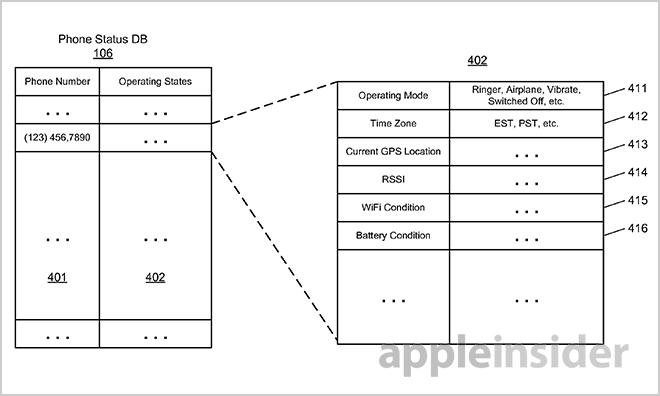An Apple patent application published by the U.S. Patent and Trademark Office on Thursday shows a system in which a caller can check another user's iPhone's status, that is whether a user is available to talk, before placing a call, in some ways like the "away" feature seen in IM clients.

Source: USPTO
Apple's patent filing, descriptively titled "Methods to determine availability of user based on mobile phone status," outlines a system that would make it easier for a caller to decide whether or not a callee is available to talk.
The idea is simple and very much like an augmented version of the "Available/Away/Offline" system used by many instant messaging programs, including Apple's own iMessage. On IM, users can see at a glance if a contact is free to chat or if they are busy through user-defined and shared presence and availability settings.
Apple points out in the document that cell phones users have the ability to screen calls by using caller ID services, but existing methods are inefficient for both callers and those who may receive calls at an inopportune time.
From the patent's background:
In particular, for most callees, the only available actions are to accept the call or decline it by either not answering or allowing an answering machine or voice mail system to respond. The caller in such cases has no control over whether or not the call will be accepted.
Apple says advanced caller ID systems offer a certain level of interactivity in call screening, but are also insufficient, especially for callers.
Instead, Apple proposes a mechanism that automatically shares a phone's operational status or "state" to would-be callers, replacing the conventional presence and availability options users set manually.
In use, a handset reports its operating status, state and condition to a cellular network's server. Examples of statuses include current operating mode (such as "ringer" or "vibration"), current location, cellular signal strength and battery life, among others. These functions are reported based on a user's sharing preferences or a device's global settings.
When a caller attempts to make a call, their handset queries the network server for the operating status of the callee's mobile device. Depending on the server's response, the caller's contact list displays the most recent status information alongside a party's phone number.
Armed with the remotely acquired data, the caller can decide whether to make the call or switch to another mode of communication, such as text messaging.
The filing notes that the process takes place largely in the background, with user interaction kept to a minimum. In other words, device owners simply set preferences and sharing policies on their iPhone, which then reports to the server at preset intervals. On the caller's side, the devices retrieve and display a contact's operating status data automatically.
While it is unclear whether Apple plans to use the operating status technology, the company is certainly capable of deploying the system as described. With privacy and device tracking issues being a hotly debated topic, however, it is unlikely that the method will be available anytime soon.
Apple's device status reporting patent application was first filed for in 2012 and credits Devrim Varoglu and Swapnil R. Dave as its inventors.

